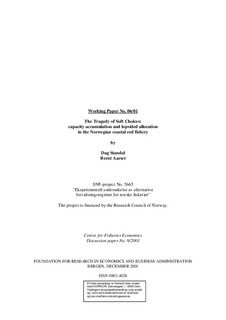| dc.contributor.author | Standal, Dag | |
| dc.contributor.author | Aarset, Bernt | |
| dc.date.accessioned | 2006-10-10T10:06:40Z | |
| dc.date.available | 2006-10-10T10:06:40Z | |
| dc.date.issued | 2001-12 | |
| dc.identifier.issn | 0803-4028 | |
| dc.identifier.uri | http://hdl.handle.net/11250/166042 | |
| dc.description.abstract | Following years of reduced stocks and catch quotas, 1989 became the "great divide" in Norwegian cod fisheries management as the open-access regime was abandoned. The government implemented a new regime for the coastal cod fishery based on "access closure" and "vessel quotas" even for the smallest boats, in accordance with the dogma that postulated closing of the marine commons as the unavoidable prerequisite for adjusting fleet capacity to available resources. However, the next ten years revealed that despite acknowledgement of the capacity problem and the use of powerful policy tools, the capacity of the coastal fleet continued to expand. This paper discusses the processes that have led to a significant increase in the capture capacity of the coastal cod fleet – opposite the intention of the public policy – and a build up of vessels in the large size segments of the coastal fleet. Processes that in particular have involved vessel renewal, technological development, and institutional changes. | en |
| dc.format.extent | 125079 bytes | |
| dc.format.mimetype | application/pdf | |
| dc.language.iso | eng | en |
| dc.publisher | SNF/Centre for Fisheries Economics | en |
| dc.relation.ispartofseries | Working Paper | en |
| dc.relation.ispartofseries | 2001:6 | en |
| dc.relation.ispartofseries | Discussion Paper | en |
| dc.relation.ispartofseries | 2001:9 | en |
| dc.title | The tragedy of soft choices : capacity accumulation and lopsided allocation in the Norwegian coastal cod fishery | en |
| dc.type | Working paper | en |
| dc.type | Working paper | en |
